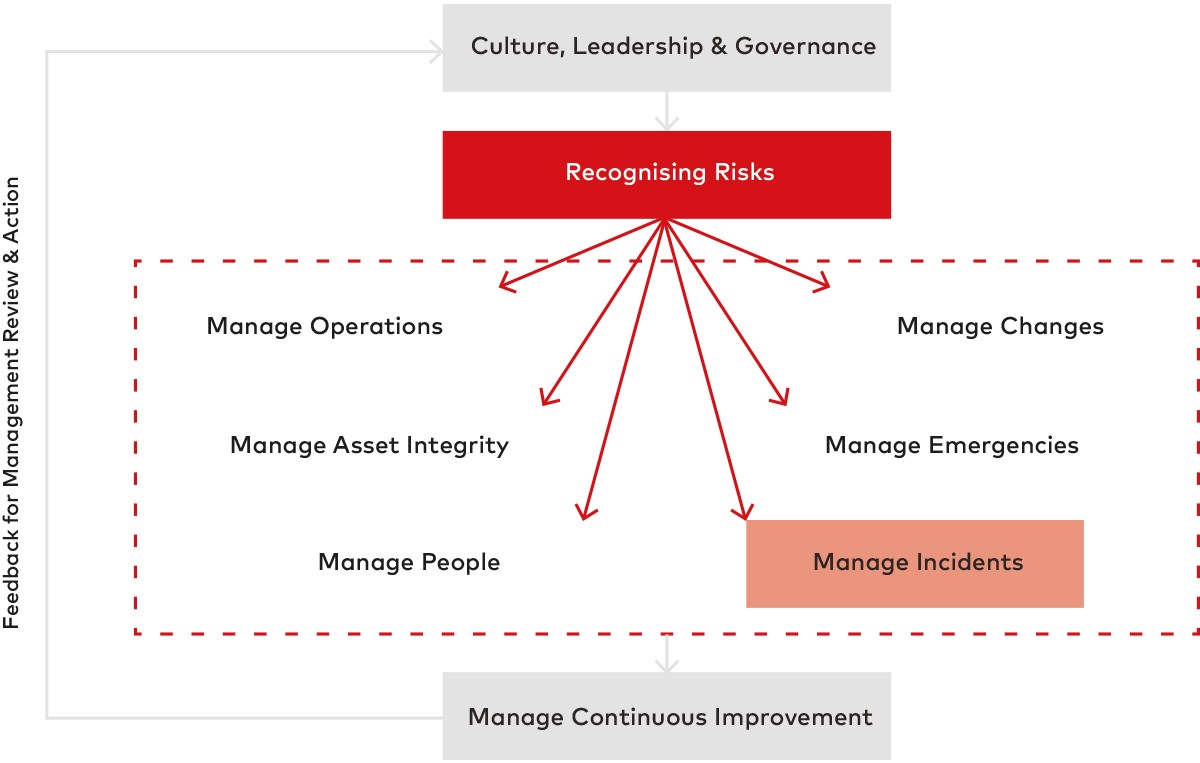Fostering a culture of trust and openness to improve incident investigations and save lives
The International Labour Organisation (ILO) estimates that more than two million workplace fatalities occur around the world every year. Learning from incidents through incident investigation is an effective tool to prevent similar incidents from reoccurring, especially in highly hazardous industries.

Incident investigation is a key component of a world class risk management framework. Through incident reporting and investigation, an organisation revisits its management systems (e.g., operations, asset integrity, leadership, culture, people/capabilities ), exploring sources of weakness and risk. By recognising and addressing risks throughout the risk management framework, an organisation can take proactive steps to prevent process incidents, which by their nature have high potential impact for both personnel and property.
As successful as incident investigation may be in driving continuous improvement, there are cultural barriers that must be overcome for its successful implementation. Building a culture where raising and investigating incidents are encouraged can overcome many of these barriers and help employees protect themselves and the organisation from process-related hazards – helping to save lives in the process.

Figure 1: A risk-based approach to managing operations, centred around recognising and prioritising risks and value drivers
What is incident investigation?
Incident Investigation is a “systematic process to find the root causes of problems and develop solutions to improve performance”1. The process is typically sponsored by a member of the leadership team (the sponsor) who assigns an investigation leader to conduct the investigation in collaboration with an appointed multi-functional team. However, not all investigations require a team - criteria for whether a team is needed should be risk-based.
Incidents are defined as events that result, or can result, directly in injury or illness, property damage, harmful environmental impact, unfavourable impact on the public or in business interruption. In addition to losses, incidents can also have dire long term impacts on the public image of an organisation.
Reasons for investigating workplace incidents include:
- Ascertaining the root causes and preventing similar incidents
- Determining the cost of an incident
- Fulfilling any legal requirements
- Implementing corrective actions
- Processing worker compensation claims.
A high-potential near miss is an unplanned event or series of events that could result in a Serious Injury and Fatality (SIF), but did not due to chance or circumstances. High potential near misses can also qualify as a trigger for a formal investigation.
While investigating incidents is indisputably crucial, two key factors can obstruct the process of reporting and investigating incidents. The first factor is front-line related, and the second is leadership related.
- The predicament of the frontline
Generally, frontline workers have the highest potential of being harmed in case of an incident. However, there are many reasons why a front-line worker might hesitate before raising an incident report, such as:- Concern of reprisal from the direct manager for raising an incident in their work area
- Embarrassment about their perceived part in the incident
- Fear of disciplinary actions, remuneration penalties or dismissal
- Impact on yearly performance review
- Lack of faith in the incident investigation process
- Creating a culture of investigation and reporting
Leaders have the potential to impact the organisational culture of reporting and investigating incidents, both positively and negatively. In an immature safety culture, a leader might actively try to discourage incident reporting to avoid tarnishing safety records, to win a safety award, or to avoid looking bad in front of other leaders. A leader that does not prioritise safety over other factors will create a culture where the whole organisation averts from acknowledging its incidents. A leader that asks questions about quality, safety, and employee concerns will send a message that these things matter. On the other hand, a leader that does not believe in safety as a core value and focuses only on revenue and profit will create a culture of shortcuts.
The enablers of a successful Incident investigation culture
Leadership is a key enabling element for an effective risk management approach (Figure 1). Strong and visible management commitment to incident investigation and reporting can drive sustainable change towards a blame-free culture. The following leadership elements are proven to drive a culture of trust and openness for support on incident reporting and investigation.
To drive effective incident reporting and investigation, leaders need to establish a culture that “welcomes the reds and challenges the greens ”
- Eliminate reporting barriers
In any Incident Investigation, leaders must walk the talk. They should demonstrate to the team that there is no barrier to raise any findings, even if it impacts directly on Key Performance Indicators (KPIs). Leaders should send a clear message to the team that the organisation can only improve by challenging an incident-free book and use incidents – even near-misses – as an opportunity for growth and learning. - Demonstrate commitment to the process
There is a great opportunity for leaders to illustrate their personal commitment to the incident investigation and reporting process. This can be done by expressing concern over the systems and processes that they are responsible for and challenging investigation teams to strengthen such systems by identifying areas where they may be improved. If leaders set the example by looking for and acknowledging weaknesses in their own systems and behaviours, employees will be encouraged to do the same. - Enable independent investigations
Leaders should ensure that the team appointed to investigate an incident includes members from a different department or function to increase independence of investigations and findings, which in turn helps strengthen employees’ trust in the incident investigation process. - Don’t just scratch the surface
Leaders play a key role in reviewing the quality and depth of the investigation and effectively set the standard to which investigations should be done. Leaders should not be afraid to set high expectations from their teams in terms of the quality and depth of the investigation. Detailed and thorough investigations contribute to uncovering more fundamental root causes, such as management systems and organisational culture issues.
In contrast, poor- quality and rushed investigations tend to only attribute causes of incidents to human and equipment errors (casual factors)2, which may not paint a complete picture.

Figure 2: Thorough investigations help uncover more fundamental root causes, such as management systems and organisational culture issues.
- Communicate learnings
Leaders can also play the important role of ensuring learnings from incidents are proactively shared and applied across the organisation to promote continuous improvement and prevent the same or similar incident from occurring elsewhere.
The following steps help to ensure proper communication of incidents:- An incident notification should be raised as soon as possible to notify the organisation that an incident has occurred
- A flash report should include a brief overview of the incident and be shared within 1-2 days, containing a description of the incident, immediate actions, preliminary findings and next steps
- A final report should include a root cause analysis, recommended actions, evidence, etc. and be shared with the team involved directly with the incident
- A “lessons learned” knowledge share, distributed across the organisation periodically, to serve as a reminder of what was learned from incidents. This communication can take various forms (e.g., toolbox talks, flyers on Bulletin boards or newsletters, a prepared safety contact that can be shared at the beginning of meetings, etc.)
- Ensure proper closure
Leaders should clearly demonstrate to the investigation team that investigations can only be closed when there is sufficient evidence that verifies that all recommendations have been properly addressed with effective and quality actions to drive intended outcomes. Moreover, the evidence should be clearly aligned with the objective of the recommendation. Consider, for example, the case of a design problem in a specific component within a variable speed pump that caused a safety incident in the past. If the objective of a recommendation was to reexamine the design of such a pump, then the evidence must not only demonstrate that the design was reviewed, but that it was reviewed specifically to address any concern regarding the component in question.
Effective incident investigation, execution of corrective actions, and communication of learnings drive a clear and strong message to the organisation that safety matters and that appropriate actions to avoid the same or similar incidents have been taken. Leaders have a key role to play in creating a culture where employees trust the incident investigation process and are encouraged to report incidents openly and to ensure continuous improvement.
Business Insiders





